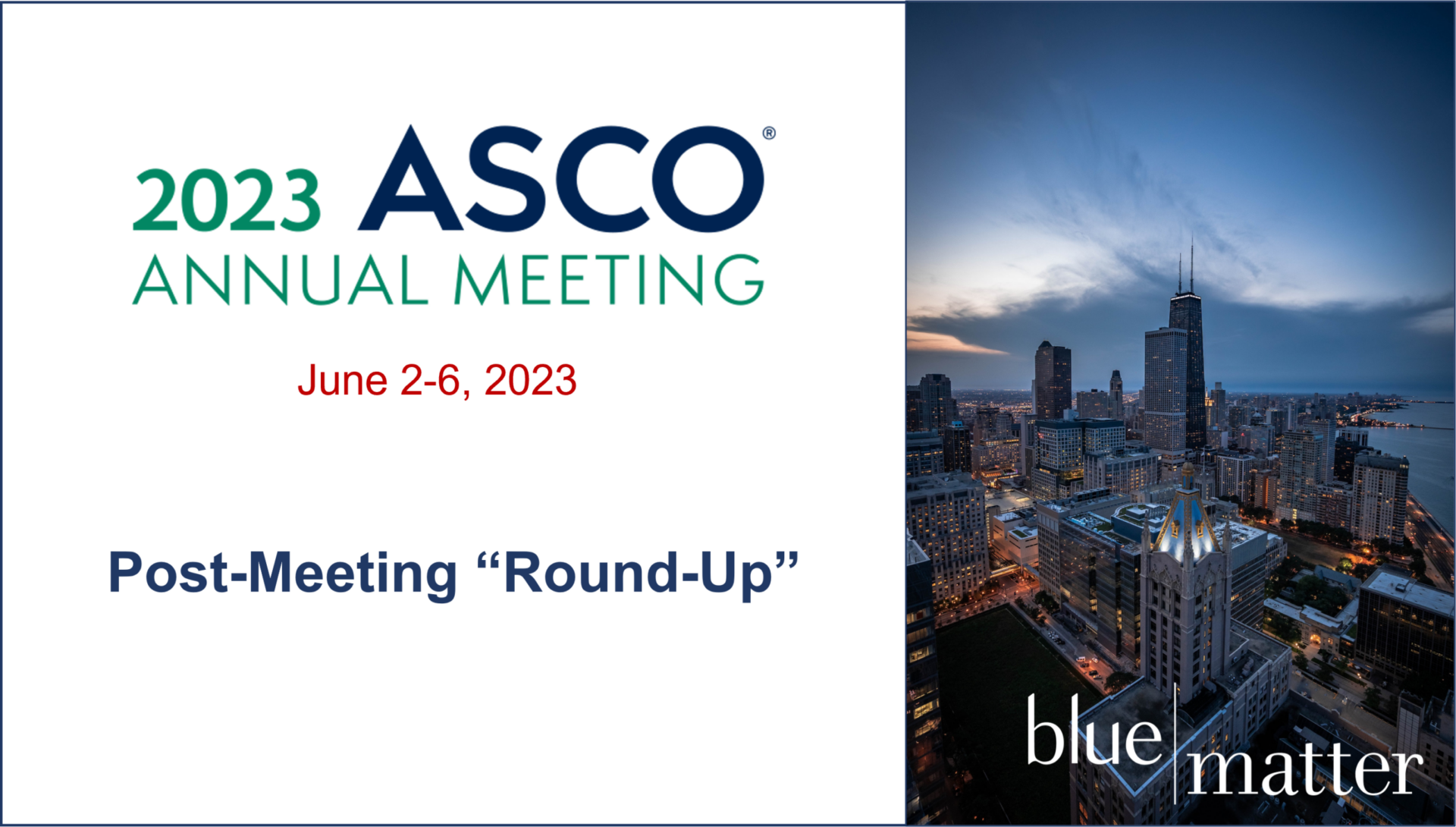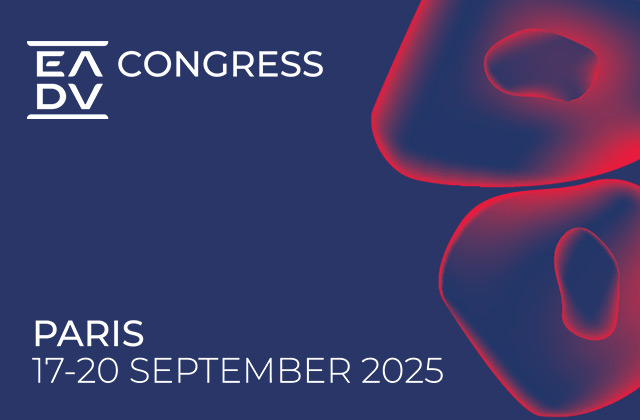
As everyone in oncology knows, the annual meeting of the American Society of Clinical Oncology (ASCO) is a pretty big deal. It’s a nexus for continuing education for oncologists, the sharing of new research data, networking and idea sharing, and more. This year, the meeting was held in Chicago from June 2-6, attracting approximately 45,000 people.
Members of the Blue Matter team were also in attendance, keeping up with the latest developments in the space. In this article, we share some of the key themes that we noticed at the meeting.
At an event of this size, it’s quite challenging to cover all 200+ sessions, so we focused our efforts. In particular, we looked at the latest developments to see if they were in line with various predictions we made in our 2023 Oncology Market Outlook. We also kept our eyes open for other major trends or announcements that stood out from the rest or that were particularly interesting for one reason or another.
Below, we’ve provided a quick and easy-to-read summary of our thoughts.
Key Themes Related to Our 2023 Oncology Market Outlook
Cancer vaccines will come into focus
In our 2023 outlook, we predicted that interest in cancer vaccines will continue to rise. Data from ASCO supports this notion. Moderna and Merck reported updated findings from the KEYNOTE-942 Phase IIb study. The personalized cancer vaccine, mRNA-4157 / V940—which encodes up to 34 patient-specific tumor neoantigens—in combination with Keytruda (pembrolizumab), reduced the risk of distant metastasis or death by 65% compared to Keytruda alone in patients with high-risk melanoma. A Phase III study is expected to be initiated this year.
Radiopharmaceuticals will further mature
2022 was a big year with the approval and initial commercial success of Pluvicto™. Despite some hiccups, it is truly on its way to becoming a blockbuster. This year, we’re still waiting for data from the PSMAfore phase III trial in taxane-naive patients that will move Pluvicto™ up the treatment paradigm. However, some ASCO presentations showcased the combinations of Lu-PSMA, truly establishing it as the standard of care (SoC), the backbone of future combinations:
- Sequential dosing of two PSMA targeting agents, 225Ac-591 (a mAb linked to a radioactive alpha emitter) and 177Lu-PSMA (a small molecule linked to a radioactive beta emitter), led to 50% reduction of PSA in 61% of metastatic castration-resistant prostate cancer (mCRPC) patients in 2nd line+.
- The combination of 177Lu-PSMA and olaparib in prostate cancer patients resulted in a 50% (or greater) reduction in PSA in 66% of the patients (44% of patients experienced a 90% reduction in PSA levels). Interestingly, this study was done in all comers regardless of BRCA status. It anchored on the potential synergies between radiation and PARP (poly-ADP ribose polymerase) inhibition. Radiation is causing double strand breaks and the inhibition of PARP will prevent cells from effectively correcting this damage.
The commercial success of bi-specifics will significantly dampen enthusiasm for allogeneic CAR-T therapies
Our 2023 outlook predicted that as the bi-specifics advance, the market will further sour on the comparatively lackluster allogeneic CAR-Ts, further pushing them to the sidelines (unless their durability challenges could be addressed).
In multiple myeloma (MM), bispecific antibodies are yet to match the efficacy benchmarks set by CAR-T therapies. However, their off-the-shelf appeal is highly attractive to community physicians whose patients cannot travel to a CAR-T treatment center, who can’t tolerate the treatment, or are unable to wait for the availability of a manufacturing slot.
Data at ASCO revealed another appealing element of bispecifics: their ease of use as part of combination approaches. Data in multiple myeloma demonstrated that the combination of Janssen bi-specific, talquetamab with daratumumab, resulted in complete response (CR) of 52% in heavily pre-treated patients.
In addition, a combination of teclistamab (BCMAxCD3) and talquetamab (GPRC5xCD3) delivered responses that are comparable with CAR-Ts. This combination demonstrated CR of 40% and sCR of ~18%, falling short of ide-cel at 29% but somewhat lagging behind cilta-cel’s 78%.
Antibody drug conjugates (ADCs) will continue to see clinical and commercial success
In recent years, ADCs started to solidify their role as the SoC across various tumor types, gaining traction in breast and bladder cancers. At ASCO, trastuzumab derotexican demonstrated compelling efficacy in tumors that highly express HER2.
The DESTINY PAN-TUMOR02 LBA3000 trial demonstrated a compelling 37% overall response rate (ORR) in patients with IHC 3+ across a variety of tumor types including cervical, endometrial, ovarian, biliary, pancreatic, bladder, and others. This data may provide the opportunity for a pan-tumor label for HER2+ cancers, similar to the label pembrolizumab achieved in MSI-H cancer.
In addition, ELAHERE (mirvetuximab soravtasine), an anti-Folate receptor alpha targeting ADC, showed interesting results for mPFS and median overall survival (mOS) data in patients with platinum resistant disease. It demonstrated mPFS improvement of close to 2 months and a hazard-ratio (HR) of 0.65. The mOS yielded close to 4 months improvement with an HR of 0.67.
These data points position Elahere as a novel treatment approach in platinum-resistant ovarian cancer, a tumor type that has not benefited as much from innovation in recent years as others.
Finally, we also had positive results from the phase 3 TROPiCS-02 trial with sacituzumab govitecan (Trodelvy®), which showed a progression-free survival (PFS) and overall survival (OS) benefit in patients with HR+/HER2‒ metastatic breast cancer (when compared to chemotherapy). The data reinforces a role for sacituzumab in R/R HR+ positive patients, in addition to the triple negative breast cancer patients, where it was initially approved.
Measurable-residual disease measurement and other diagnostics will start to significantly impact patient management
GRAIL, which markets the Galleri® multi-cancer early detection (MCED) test, presented results from the SYMPLIFY study. It showed the performance of multi-cancer early detection (MCED) testing in people presenting with non-specific symptoms. The results showed that among 6,238 symptomatic patients (“suspicion of cancer” workup), the test had an overall sensitivity of ~67%. Furthermore, the test was able to pinpoint the original site of cancer in 85% of those who showed positive. While these data are impressive, it is unclear if these are compelling enough to drive broad uptake of the test, particularly without widespread payer coverage.
Additional Noteworthy Themes
Some studies challenge the current SoC and are likely to reshape the treatment paradigm
This study showed a highly compelling PFS benefit and is likely to position Carvykti™ (cilta-cel) as the best-in-class treatment for len-refractory multiple myeloma patients, advancing the CAR-T treatment from the back of the line (4L+) to the front.
The study demonstrated a PFS HR of 0.26 with mPFS not reached in the cilta-cel arm vs. mPFS of 11.8 months in the control arm. Cilta-cel patients reached ORR of ~85% with 73% of the patients achieving CR or sCR (stringent CR) compared with 67% ORR and 22% CR or sCR in the control arm.
Janssen is still facing a challenge to meet demand in later lines of therapy with some patients waiting for months to receive the treatment. In the absence of mature OS data or data regarding crossover from control arm to treatment arm, physicians are trying to determine how they should prioritize between late-line patients for whom treatment options are scarce and earlier-line patients who are likely to drive a longer benefit from this treatment.
This study demonstrated the benefit of continued immuno-oncology (IO) treatment in the adjuvant setting. In part, it addresses a question that was posed by the Checkmate-816 trial, which studied nivolumab plus chemotherapy as neoadjuvant treatment, and the AEGEAN study that evaluated durvalumab + chemotherapy as neoadjuvant and durvalumab alone as adjuvant treatment in a similar patient population.
Checkmate-816 and AEGEAN yielded similar outcomes, leaving physicians to struggle with the question of whether to continue IO treatment in the adjuvant setting. KN671 seems to answer this question, at least for pembrolizumab.
Randomized early-stage NSCLC patients either received
- Pembrolizumab plus chemotherapy as neoadjuvant treatment followed by surgery and adjuvant pembrolizumab, or
- Chemotherapy followed by surgery and placebo in the adjuvant setting
The event-free survival (EFS) HR was 0.58, with median event-free survival (mEFS) not reached in the pembrolizumab arm compared with 17 months in the placebo arm. Overall survival (OS) HR was 0.73 however, which was not statistically significant at the time of interim analysis.
Ribociclib is a CDK4/6 inhibitor that has demonstrated improved overall survival in metastatic HR+ breast cancer. The NATALEE trial aimed to test the benefit of ribociclib in conjunction with SoC endocrine therapy as an adjuvant treatment in early HR+/HER2- BC, specifically stages IIa, IIb, and III disease.
Data from this 5,101-patient study demonstrated that adding ribociclib to endocrine therapy (ET) reduced the risk of recurrence by 25% compared with ET alone and provided clinically meaningful improvement in invasive disease-free survival (iDFS). Though an early dataset, these results are practice-changing and support ribociclib + ET as a new SoC in early HER+/HER2- breast cancer at risk of recurrence, including patients with node-negative disease. Novartis plans to file for approval in the adjuvant setting later this year for ribociclib (Kisqali®).
In addition, Lilly’s Verzenio® (abemaciclib), which was approved for the same indication in 2021, also had some updated data at ASCO 2023, and will now likely have to look forward to competing with Kisqali® in this space.
For many years 2nd line large B-cell lymphoma (2L LBCL) patients were treated with chemotherapy followed by stem cell transplant. The ZUMA-7 study suggests that oncologists should do away with the chemotherapy and stem cell transplant, replacing them with CAR-T treatment instead.
Yescarta’s approval in 2L LBCL in April 2022 , based on the ZUMA-7 trial, challenged that paradigm. It demonstrated an event-free survival (EFS) of 40% with Yescarta® vs. 16% for the SoC. It also showed an mEFS of 8.3 months for Yescarta vs. 2 months for the SoC.
At ASCO, Kite presented the final OS analysis. It showed an HR of 0.73, with mOS not reached in the Yescarta arm and 31 months for the SoC patients.
More than 57% of patients in the control arm received CAR-T treatment upon progression. Yescarta maintained an OS benefit despite the large proportion of patients receiving CAR-T in later lines of treatment. This cements the idea that patients who receive CAR-T in early lines of treatment derive a greater benefit than those that receive it in later lines.
AstraZeneca received approval for osimertinib, an EGFRm targeting inhibitor, as an adjuvant treatment for early-stage NSCLC (Stage IB-IIIA) in 2020 based on tripling disease-free survival (DFS) and a risk-reduction of ~70%. At ASCO the OS data was presented showing an HR of 0.49, solidifying osimertinib’s position as an adjuvant treatment for patients with EGFR mutations.
Despite the impressive outcomes, critics of the study noted that randomizing patients to placebo does not reflect true SoC, where patients, especially IIB-IIA patients, should be offered chemotherapy followed by
Speeding up cell therapy manufacturing
Manufacturing for cell therapies continues to be a challenge with approved BCMA-targeting CAR-Ts. Novartis and Gracell provided an update from Phase 1 trials with their BCMA-targeting CAR-Ts, featuring novel manufacturing strategies that allow for a shorter manufacturing and total vein-to-vein time. The data demonstrated that there is minimal tradeoff between rapid manufacturing and efficacy.
- Patients had a median of 4 prior lines of treatment
- A large majority of the patients were penta- and triple-refractory
- Results were comparable to Ida-cel with CR/sCR at 41%
- BCMAxCD19-targeting CAR-T
- Results were highly impressive and comparable to cilta-cel with CR/sCR of ~83%
Microbiome and impact on IO sensitization
The microbiome-dedicated session on Sunday, June 4 was a “first” at ASCO, highlighting emerging evidence on the role of the microbiome in immune modulation, with specific implications on how it impacts the efficacy of immune checkpoint inhibitors, CAR-T cell therapies, and hematopoietic stem cell transplantation. Presentations during this session demonstrated the clinical impact of the microbiome in:
- Overcoming resistance to aPD-1 inhibitors – Dr. Park, et al at the University of Ullsan College of Medicine in South Korea conducted a single arm prospective clinical study in advanced solid tumor patients. They assessed whether allogeneic fecal microbial transplantation (FMT) can circumvent primary resistance to PD1 blockade. Among 13 FMT recipients, 1 achieved a partial response (PR) and 5 showed stable disease (SD), resulting in a 7.7% ORR and disease control rate (DCR) of 46.2%. These data demonstrate that FMT can transform response to PD-1/PD-L1 inhibitors, offering greater promise for more patients to benefit from checkpoint inhibitors.
- Increasing response to PD-1 regimens – Dr. Ebrahim, et al from the City of Hope Comprehensive Cancer Center in Los Angeles conducted a 30-patient study to understand the relative benefit of probiotic clostridium butyricum in 1L RCC treated with SoC PD-1 + TKI (nivolumab + cabozantinib). Impressively, compared with progression free survival (PFS) in the control group of 5.8 months, mPFS for the test arm was not reached, with Kaplan-Meier curves demonstrating a significant increase in PFS and higher response rate overall. These data compellingly underscore the promise of single-organism probiotic supplementation to enhance patient response to IO-regimens, and support broader evidence generation via a phase III study.
Platinum drug shortages in the US
For several months, the US has been experiencing a dramatic shortage in generic drugs, including essential platinum chemotherapies used across lines of therapy and sometimes with curative intent, such as carboplatin and cisplatin. According to Julie R. Gralow, MD, FACP, FASCO, Chief Medical Officer and EVP of ASCO, “This shortage is among the most severe we have seen in a long time, and its ripple effects are being felt across the country.” The shortage is driven in part by global supply chain issues and increasing costs of manufacturing, which were related to the larger issue of pandemic supply chain constraints felt across industries.
US policymakers are currently working to assess and address this shortage. In the meantime, though, cancer patients and their physicians have had to grapple with difficult decisions of how to prioritize patient care in the midst of the shortages.
ASCO has issued 7-point clinical guidance on rationing chemotherapy, including use of evidence-based alternative treatments, increasing dosing intervals per guidelines, and optimizing vial usage.
During this annual meeting, ASCO shared tumor-specific guidance for GI cancers, including chemotherapy substitutions and prioritization of patient needs. ASCO has also supported the Society of Gynecologic Oncology’s (SGO) recommendations for the treatment of gynecological cancers. Additional disease-specific guidance from ASCO will be forthcoming.
Stay Tuned for More
Hopefully, you’ve found this quick roundup to be interesting and informative. We will continue to monitor the market and provide our perspectives on new trends and developments as appropriate. We also plan to be on hand at the ASH meeting in San Diego, December 9-12. Our goal will be to provide a similar summary after that meeting, too.








